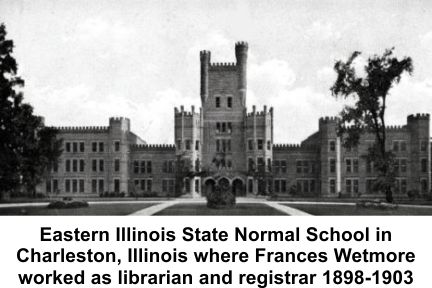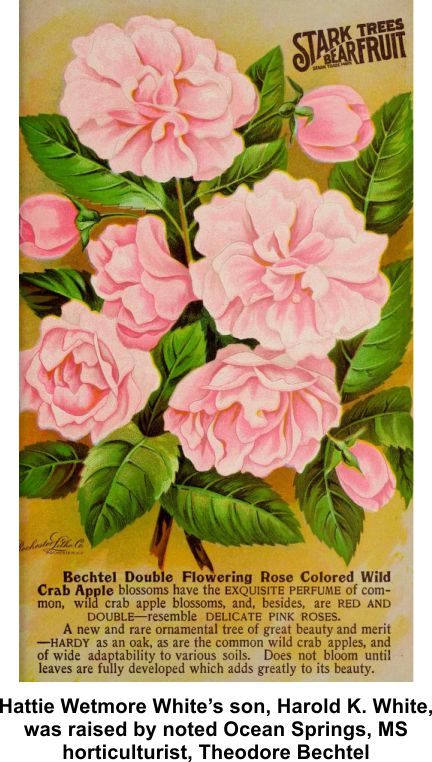|
Thirty-one-year-old Frances Estella
Wetmore (b.1872), called Stella by her
family, was the librarian and registrar
at the Eastern Illinois State Normal
School in Charleston, Illinois, a small
city in mid central Illinois.
Over the 1903 Christmas holiday she came to
visit her parents and siblings in
Chicago. On Wednesday afternoon,
December 30, 1903, as the holiday drew
to an end, Frances and one of her
sisters, twenty-seven-year-old Harriet
"Hattie" Amelia Wetmore White (b. 1876),
attended a matinee performance of Klaw &
Erlanger's Mr. Bluebeard
musical fairytale at Chicago's newest luxury playhouse,
the Iroquois Theater. They became two of
the nearly six hundred people who
died that afternoon in America's worst
theater disaster.
One of their brothers, Charles Quin Wetmore
(1879–1938), found Frances' body at Carroll's
funeral home two days later, making the
identification on the basis of her shoes and
stockings. Hattie's body was identified by her
brother-in-law, Carlos Freed White.
A double funeral was held on Monday morning after
the fire. Frances and Hattie were buried in the Wetmore plot
in Mount Greenwood Cemetery in Chicago. They would
later be joined by their parents and two of their
siblings.
|
|
|
Hattie and Frances were the daughters of
Canadian-born William T. Wetmore (1844–1926), and
Sarah Susan Troutwine Wetmore (1844–),* an Iowa
native and one-time music teacher. Married in 1868,
William and Sarah lived in Ohio near Cincinnati when
their seven children were born, of which five
survived prior to the Iroquois Theater fire, two
having died in infancy.
In 1900 Hattie, her husband, Kansas native Walter K. White
(1873–1905), and their preschool son, Harold, lived
at the corner of 10619 Drew and 107th Street in the
Washington Heights area south of Chicago with
Hattie's parents, William and Sarah, and two
siblings, Charles, his wife, Florence, and the
youngest of the Wetmore children, Nellie Lou White (1884–1971).
William Wetmore was a successful architect, building
contractor and realtor. In addition to their
home in Chicago they had a farm in
North Judson, Indiana and wintered in Florida.
Eastern Illinois State Normal school
Foundation of today's Eastern Illinois University, the
school was organized in 1895 to train public school teachers in
east central Illinois. The library over which
Frances had responsibility housed sixteen thousand
books. As registrar, Frances also kept track of
records for several hundred students.

On January 9, 1904 a memorial service was held at
Frances' school where she had worked for five years
prior to the fire.
|

|
In the years after the fire
William and Sarah Wetmore may have wanted to lock up
their daughters to keep them safe. Hattie and
Frances had been gone for only four months
when twenty-year-old Nellie Lou, their youngest, went to the St. Louis
worlds fair with a friend, partied hearty and in the
wee hours of the morning, married a handsome waiter
named Charles — who already had a wife.
Charles was prosecuted but not before Nellie gave
birth to his son.† William and Sarah lived
long enough to see her remarried to a better
prospect.
Hattie's husband, Walter White, passed in 1905, orphaning
their seven-year-old son, Harold. He was raised in
Ocean Springs, Mississippi by his father's sister, Jessie
White Bechtel and her husband, Theodore Bechtel.
 (Though his most important achievements were with pecans, Bechtel's
art has graced American landscaping since 1898 in the form
of the Bechtel Flowering Crab Apple Tree.) As an adult Harold served
in World War I then married Elizabeth Johnston, with
whom he had one child, Harold Kirke White Jr., and
became president of Weber Bros and White Metal Works
in Chicago.
‡ His son, Harold Jr, served in World War
II and probably also worked with WB&WMW. In
retirement Harold Sr and Elizabeth settled in
Saugatuck, Michigan.
(Though his most important achievements were with pecans, Bechtel's
art has graced American landscaping since 1898 in the form
of the Bechtel Flowering Crab Apple Tree.) As an adult Harold served
in World War I then married Elizabeth Johnston, with
whom he had one child, Harold Kirke White Jr., and
became president of Weber Bros and White Metal Works
in Chicago.
‡ His son, Harold Jr, served in World War
II and probably also worked with WB&WMW. In
retirement Harold Sr and Elizabeth settled in
Saugatuck, Michigan.
Frances and Hattie's mother, Sarah Troutwine Wetmore, died in 1916.
William remarried the following year to his late brother James' widow,
Miriam M. Munro Wetmore (sometimes called Marian). A sweet newspaper story
told of a sixty-eight year friendship, loneliness and William's wish for Marian
to receive his pension as a veteran of the Civil War. The story stated
William had been a widow for thirteen years but multiple records show that Sarah
died in July, 1916 and William and Marian married not thirteen but one year
later, in July, 1917. They had a decade together before William's death in
1926 at age eighty-two.
|
|
Discrepancies and addendum
Munger, Vokoun, Wetmore &
Witherbee insured the Iroquois Theater. I
haven't yet learned if the E.R. Wetmore was related
to the family in this story.
* Sarah was nicknamed Sally.
† Nellie sent a telegram with her happy news to a
cousin who ratted. Her father, William, quickly moved
to separate the newlyweds, and Nellie's common sense kicked in,
motivating her to look through hubby's belongings where she
found evidence of another wife. Prosecuted for
bigamy in May, 1905, confronted in court by his two
young wives, Charles explained that 1.) He was drunk
at the time of the marriage to Nellie, 2.) He wasn't
sure if the first wedding to the Buffalo, NY girl
was valid because the bride's mother objected to his
being a Protestant, 3.) he had heart problems
brought on by all the problems caused by his
irresistibility to women.
‡ Founded in 1885 and still in business, now in
Hamilton, MI. The original Weber Bros. Metal Works
was where George Stephens invented the famous Weber
grill. In 1936 Harold and George patented a
pulverizing mill.
A Weber grill fan site tells the story of Harold's
retirement from the company and includes a picture
of him.
|
